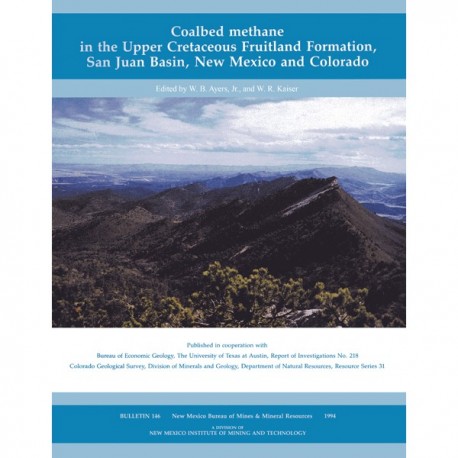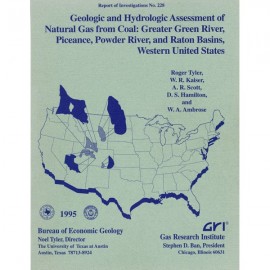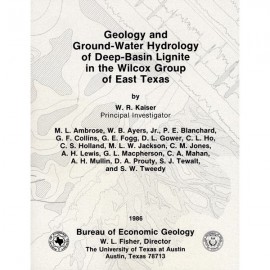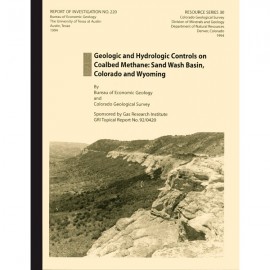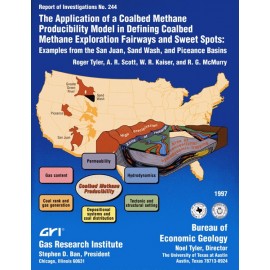Reports of Investigations
-
Books & Reports
- Reports of Investigations
- Guidebooks
- Udden Series
- Geological Circulars
- Down To Earth
- Atlases of Major Oil and Gas Reservoirs
- Texas Memorial Museum Publications
- Environmental Geologic Atlas of the Texas Coastal Zone
- Mineral Resource Circulars
- Other Reports
- Seminars and Workshops
- Handbooks
- Submerged Lands of Texas
- Symposia
- Annual Reports
- Open File Reports
-
Maps & Cross Sections
- Thematic Maps
- Miscellaneous Maps, Charts & Sections
- Geologic Atlas of Texas
- STATEMAP Project Maps
- Geologic Quadrangle Maps
- Cross Sections
- Highway Geology Map
- Energy and Mineral Resource Maps
- Shoreline Change and Other Posters
- Wilcox Group, East Texas, Geological / Hydrological Folios
- Bouguer Gravity Atlas of Texas
- River Basin Regional Studies
- Featured Maps
- Posters
- Teachers & the Public
-
Geological Society Publications
- Gulf Coast Association of Geological Societies
- Alabama Geological Society
- Austin Geological Society
- Corpus Christi Geological Society
- Houston Geological Society
- Lafayette Geological Society
- Mississippi Geological Society
- New Orleans Geological Society
- South Texas Geological Society
- GCS SEPM Publications
- Historic BEG & UT Series
Coalbed Methane in the Upper Cretaceous Fruitland Formation, San Juan Basin, New Mexico and Colorado
RI0218
For a downloadable, digital version: RI0218D.
RI0218. (Copublished with Colorado Geological Survey). Coalbed Methane in the Upper Cretaceous Fruitland Formation, San Juan Basin, New Mexico and Colorado. W. B. Ayers, Jr. and W. R. Kaiser, eds. 216 p., 168 figs., 14 tables, 1994. Print.
To purchase this publication as a downloadable PDF, please order RI0218D.
From the Preface
Coalbed methane is playing an increasingly important role in meeting the energy needs of the United States. According to one estimate, this unconventional gas may supply 4-5% of the domestic natural gas in 1994. In the San Juan Basin, Fruitland Formation coal beds contain an estimated 43 to 49 trillion cubic feet (Tcf) of methane. This basin is the most active area of coalbed methane development and production in the United States. The San Juan Basin led the nation in coalbed methane production in 1992, when nearly 2,100 Fruitland coalbed wells produced approximately 447 billion cubic feet (Bcf) of coalbed methane-81% of the total U.S. coalbed methane production of approximately 553 Bcf.
From August 1987 through July 1990, the Bureau of Economic Geology (BEG) at The University of Texas at Austin evaluated geologic and hydrologic controls on the occurrence and producibility of coalbed methane in the Fruitland Formation for the Gas Research Institute (GRI). The Colorado Geological Survey and the New Mexico Bureau of Mines and Mineral Resources participated in the research through subcontracts with BEG. Results from the first two years of research were summarized in annual reports to GRI (GRI-8810322.1 and GRI-9010014.1, respectively). A topical report submitted to GRI in 1991 (GRI-9110072) superseded those annual reports, integrating their contents with research results from the final year of the study. This publication includes all except two papers from that topical report. Themes of the omitted papers were generic; therefore, those papers were omitted to focus this publication on the San Juan Basin.
The unpublished GRI contract reports had limited distribution. Their goal was the timely transfer of technology to industry. Because requests for the topical report exceeded the number of copies printed and because many of the topics covered in this research appeal to a broad audience of geoscientists and engineers, this publication was issued to increase the availability of the research results. This report discusses five areas that relate to controls on the occurrence or producibility of coalbed methane.
The first topic, the tectonic setting of the San Juan Basin, reviews regional tectonic controls on depositional systems and coalbed attitude. Among the most important geologic factors affecting the occurrence and producibility of coalbed methane is the depositional setting, which is covered in the second part of this report; a chapter on the regional depositional setting of Fruitland coalbed methane is followed by two chapters describing local studies. Fracture patterns in Fruitland coal beds and adjacent strata are addressed in three chapters that discuss regional cleat trends and lineament analysis. Studies of hydrology, thermal maturity, and gas composition, are essential to understanding and predicting regional hydrodynamics and coalbed gas content and composition; these considerations are the subject of two chapters. Finally, the last topic is the integration of geologic and hydrologic studies. In this section we summarize gas and water production from Fruitland coal beds, and on the basis of the relations between production, geologic setting, and hydrodynamics, we divide the San Juan Basin into regions in which Fruitland coal beds have similar reservoir characteristics.
Keywords: coalbed methane, Fruitland Formation, San Juan Basin, Colorado, New Mexico, hydrology, tectonics
CONTENTS
Preface
Acknowledgments
TECTONIC SETTING
1. Tectonic setting of the San Juan Basin
S. E. Laubach and C. M. Tremain
Abstract
Location and structure of the basin
Evolution of the basin
Minor structures and stress regime
Acknowledgments
DEPOSITIONAL SETTING
2. Coalbed methane in the Fruitland Formation, San Juan Basin-depositional and structural controls on occurrence and resources
W. B. Ayers, Jr.. W. A. Ambrose, and J. S. Yeh
Abstract
Introduction
Regional geologic setting and stratigraphy
Previous studies
Objectives
Methods
Structural evolution of the San Juan Basin
Structure of Huerfanito Bentonite Bed
Elevation of Pictured Cliffs Sandstone
Depositional framework of the Pictured Cliffs Sandstone and the Fruitland Formation
Huerfanito Bentonite Bed to top of upper Pictured Cliffs tongues (markers 20 to 58)
Upper Pictured Cliffs tongues (markers 50 to 58)
Isopach
Lithofacies
Fruitland Formation isopach (markers 50 to 64)
Huerfanito Bentonite Bed to base of Ojo Alamo Sandstone (markers 20 to 80)
Fruitland coal
Coal identification
Coal stratigraphy
Coal overburden
Coal distribution
Net coal thickness
Maximum coal thickness
Number of coal seams
Average coal thickness
Geologic controls on occurrence of coal seams
Previous studies
Relations between depositional systems and coal occurrence
Geologic controls on producibility of coalbed methane
Coal and coalbed methane resources
Conclusions
Acknowledgments
3. Geologic controls on coalbed methane occurrence and production in the Fruitland Formation, Cedar Hill field and the COAL site
W. A. Ambrose and W. B. Ayers, Jr.
Abstract
Introduction
Objectives
Methods
Stratigraphic and structural setting
Depositional systems
Pictured Cliffs Sandstone
Fruitland Formation
Lower Fruitland subunit
Middle Fruitland subunit
Upper Fruitland subunit
Fruitland coal groups
Coal group A
Coal group C
Lower C coal seams
Middle and upper C coal seams
Coal group D
Depositional controls on coalbed continuity and structural attitude
Controls on coalbed permeability
Formation pressure
Coalbed methane resources
Gas production trends
Water production
Conclusions
Acknowledgments
4. Coalbed methane in the Fruitland Formation, Navajo Lake area-geologic controls on occurrence and
Producibility
W. B. Ayers, Jr., and S. D. Zellers
Abstract
Introduction
Objectives
Methods
Regional geologic setting and stratigraphy
Structural evaluation
Structure of Huerfanito Bentonite Bed
Elevation of Pictured Cliffs Sandstone and top of the Fruitland Formation
Isopachous trends
Huerfanito Bentonite-Pictured Cliffs Sandstone isopach
Fruitland Formation isopach
Sedimentary facies
Pictured Cliffs lithofacies
Pictured Cliffs Sandstone
Upper Pictured Cliffs Sandstones (UP1 and UP2)
Fruitland Formation lithofacies
Coal occurrence
Net coal thickness
Maximum coal thickness
Number of Fruitland coal seams
Depositional controls on coal occurrence, trends, and thickness
Structural controls on depositional systems
Structural controls on producibility of coalbed methane
Coalbed methane activity and reservoir conditions
Summary and conclusions
Acknowledgments
FRACTURE PATTERNS
5. Fracture (cleat) patterns in Upper Cretaceous Fruitland Formation coal seams. San Juan Basin
C. M. Tremain, S. E. Laubach, and N. H. Whitehead, III
Abstract
Introduction
Characteristics of Fruitland Formation cleat
Cleat types and cleat spacing
Causes of variation in cleat spacing
Cleat-filling minerals
Cleat orientation
Basin-scale cleat-strike domains
Faults and associated fractures
Timing and cause of cleat formation
Implications for coalbed methane exploration and development
Acknowledgments
6. Fracture swarms: potential targets for methane exploration in Upper Cretaceous sandstone and coal, northern San Juan Basin, Colorado
S. E. Laubach and C. M. Tremain
Abstract
Introduction
Regional cleats and joints
Fracture-trace maps
Map areas: Fort Lewis mine and Animas-Florida river transect
Fracture swarms
Small-scale fracture swarm: Carbon Junction outcrop
Reservoir-scale fracture swarms: Fort Lewis mine
Surficial (set 11) fractures at Fort Lewis mine
Shape and microstructure of swarm (set I) fractures
Fracture swarm dimensions and orientation
Fracture patterns within swarms
Fracture connectedness
Relation of swarms in sandstone to coal fracture patterns
Regional-scale fracture swarms: Animas-Florida river exposure
Causes of fracture development
Fracture swarms: targets for natural gas exploration
Summary
Acknowledgments
7. Use of lineament attributes to predict coalbed methane production in the northern San Juan Basin
R. W. Baumgardner, Jr.
Abstract
Purpose
Review of lineament and fracture studies in the San Juan Basin
Data sources and procedures
Results
Definition of significant lineament azimuths
Coincidence of lineaments from different studies
Lineament azimuth
Well-lineament distance
Correlation between lineament attributes and production
Distance from well to nearest lineament
Length of nearest lineament
Lineament intersections within a given radius
Number of lineaments within a given radius
Discussion
Stress in the study area
Lineaments and stress
Conclusions
Acknowledgments
HYDROLOGY, THERMAL MATURITY, AND GAS COMPOSITION
Hydrologic framework of the Fruitland Formation, San Juan Basin
8. W. R. Kaiser, T. E. Swartz, and G. J. Hawkins
Abstract
Introduction
Hydrodynamics
Hydraulic head
Equivalent fresh-water head
Potentiometric surface
Potentiometric mounds
Pressure regime
Hydrochemistry
North-central basin
Chemical evolution
Chlorinity
Hydrostratigraphy and regional flow
Abnormal formation pressure
Cross-sectional modeling
Hydrostratigraphy
Computer program
Modeling
Model limitations
Model simulations
Model simulations 1 and 2
Model simulation 3
Recharge and discharge
Conclusions
Acknowledgments
9. Thermal maturity of Fruitland coal and composition of Fruitland Formation and Pictured Cliffs Sandstone gases
A. R. Scott, W. R. Kaiser, and W. B. Ayers, Jr.
Abstract
Introduction
Objectives
Methods
Thermal maturity of Fruitland coal
Composition and distribution of Fruitland and Pictured Cliffs gases
Fruitland Formation gases
Fruitland Sandstone gases
Fruitland coalbed gases
Pictured Cliffs Sandstone gases
Relation of gas composition to thermal maturity and pressure regime
Origins of Fruitland coalbed gases
Conclusions
Acknowledgments
INTEGRATION OF GEOLOGIC AND HYDROLOGIC STUDIES
10. Coalbed methane production, Fruitland Formation, San Juan Basin: geologic and hydrologic controls
W. R. Kaiser and W. B. Ayers, Jr.
Abstract
Introduction
Production
Decline behavior
Production statistics
Maximum annual gas production
Initial gas potential
Water production
Coalbed methane production history and trends
Controls on coalbed methane production
Coal occurrence, trends, and thickness
Coal rank
Reservoir pressure
Tectonic fractures and cleats
Gas composition
Produced water
Regional characterization of Fruitland coalbed reservoirs
Area 1: regionally overpressured area
Meridian 400 area
Cedar Hill field
Allison unit
Area 2: underpressured, regional discharge area
WAW-Gallegos area
Area 3: underpressured, eastern area
Conclusions
Acknowledgments
REFERENCES
Citation
Ayers, W. B., Jr., and Kaiser, W. R., editors, 1994, Coalbed Methane in the Upper Cretaceous Fruitland Formation, San Juan Basin, New Mexico and Colorado: The University of Texas at Austin, Bureau of Economic Geology, Report of Investigations No. 218, 216 p.
